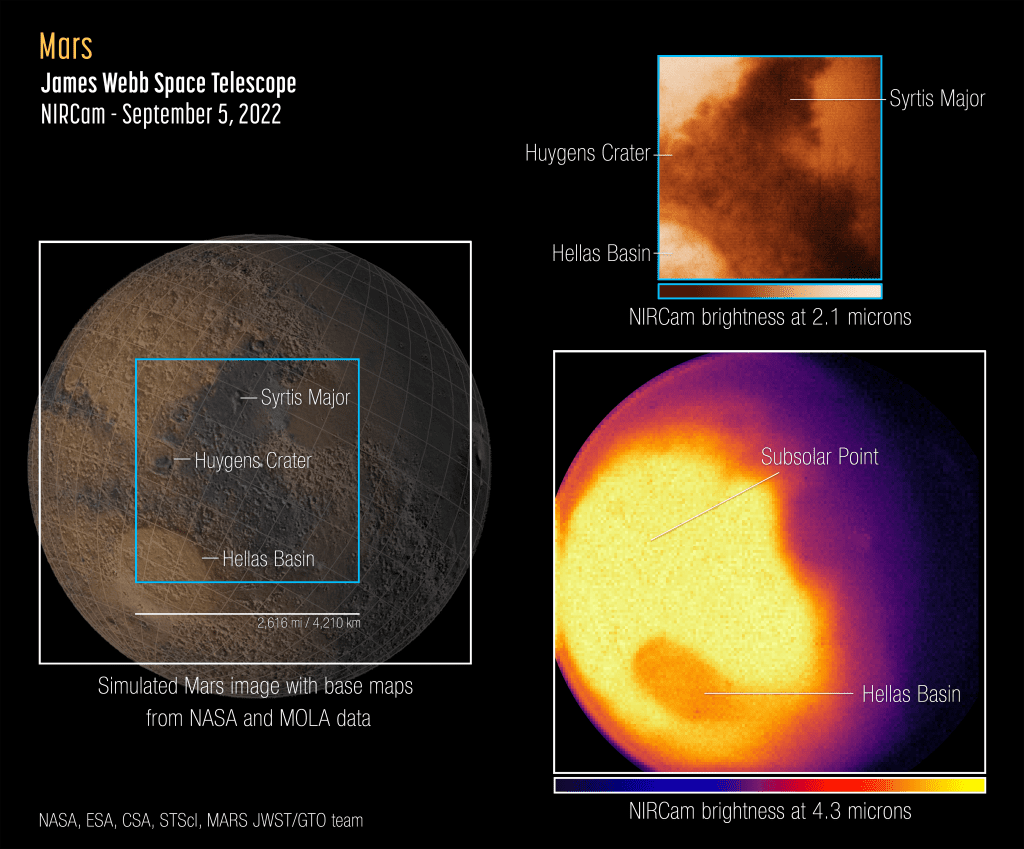The James Webb space telescope (JWST) is perhaps the most sophisticated astronomical instrument humans have ever built. Its infrared-sensing instruments are so sensitive that they can peer so far away that it can literally see back in time to the infancy of the universe.
But recently, astronomers have pointed JWST much closer to home. After observing Jupiter and its famous rings in August, the iconic space telescope has now imaged Mars, the closest planet to the space telescope besides Earth.

Because it’s so close, Mars appears extremely bright compared to other objects in the night sky, which would normally blind JWST. However, the Webb team tweaked the Near-Infrared Camera (NIRCam), using very short exposures to measure only a tiny fraction of the visible and infrared light hitting its detectors to overcome the challenge of imaging the red planet. They also applied sophisticated data processing techniques to filter out noise, thereby revealing new insights about Mars’ surface and atmosphere that had previously been obscured.
For instance, Webb’s ultra-sensitive infrared detectors picked up thermal emissions from the giant Hellas Basin — the largest well-preserved impact structure on Mars, spanning more than 2,000 kilometers across the southern hemisphere — showing that it is unexpectedly darker than the nearby area during the hottest time of the day.
“This is actually not a thermal effect at Hellas,” explained the principal investigator, Geronimo Villanueva of NASA’s Goddard Space Flight Center, who designed these Webb observations. “The Hellas Basin is a lower altitude, and thus experiences higher air pressure. That higher pressure leads to a suppression of the thermal emission at this particular wavelength range [4.1-4.4 microns] due to an effect called pressure broadening. It will be very interesting to tease apart these competing effects in these data.”
In the image above taken by JWST’s NIRCam, you can see the giant Hellas Basin, along with the rings of the Huygens Crater and the dark volcanic rock of Syrtis Major are visible. The left-hand side panel features a surface reference map taken by the Mars Orbiter Laser Altimeter (MOLA), with the two fields of view from the Webb NIRCam instruments overlaid, whereas the two right-hand side panels feature images taken by Webb in two infrared frequencies (2.1 microns for top right and 4.3 micros in the lower right panel).
The brightest regions in these maps correspond to where the Sun is nearly overhead. The brightness decreases toward the polar regions, as expected, as they receive less sunlight. The northern hemisphere, which is currently experiencing winter, also shows up in ‘blue’, meaning it’s less bright.

The space telescope’s spectrograph also mapped the planet’s atmospheric composition in infrared, revealing the presence of carbon dioxide at different wavelengths, as well as carbon monoxide and water vapor. Besides atmospheric composition, Webb’s Near-Infrared Spectrograph (NIRSpec) also revealed the spectral features of dust, icy clouds, and all sorts of rocks on the planet’s surface. These figures are preliminary and the Webb team plans on showing us Mars’ atmosphere in greater detail in an upcoming paper.






